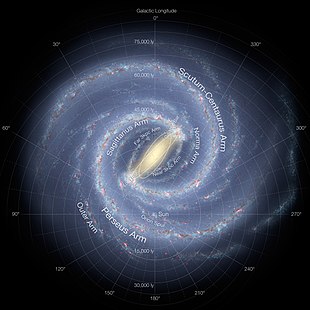
Back جمهرة النجوم Arabic Població estel·lar Catalan Stjernegenerationer Danish Population (Astronomie) German Αστρικοί πληθυσμοί Greek Stellar population English Stela loĝantaro Esperanto Población estelar Spanish جمعیت ستارهای Persian Tähtipopulaatio Finnish

Stars are grouped into stellar populations, depending on the fractions of chemical elements inside the star. In astronomy, all elements except hydrogen and helium are called metals. Elements like carbon and oxygen are called metals in astronomy, even though they are non-metals in chemistry. The metallicity of a star is the amount of metals in it.
There are three stellar populations: population 1, population 2, and population 3.
- Population 1 stars have high amounts of metals, like our Sun. They are mostly found in the spiral arms of the Milky Way Galaxy. They are the newest stars.
- Population 2 stars have low amounts of metals. They are mostly found in the central bulge of the Milky Way Galaxy. They are older stars.
- Population 3 stars have not been seen directly. They probably lived early in the Universe. They would have had almost no metals - they would be almost entirely hydrogen and helium. These stars probably created the first heavy elements that became part of later stars.